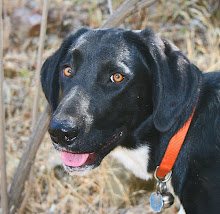
The tarsal organ is that dark patch of hair on the inside of this buck's hindleg.
It's one of the black-tailed deer's 5 specialized skin glands, and it is also the most obvious and complex.
The organ is a thickened patch of glandular skin, covered with coarse bristly hair, and each hair has an unusually large
arrector pili muscle.
The skin of the organ is deeply embedded with sebaceous and sudorifierous glands, meaning it produces BO's dynamic duo --sweat and sebum (or skin oil).
The arrector pili seem to control the dissipation of the scent. When they contract they probably squeeze the glandular products to the surface. By raising and flattening the hair they also likely control the dissipation of the scent.
Black-tailed deer aren't alone in having tarsal glands. White-tailed deer, caribou and their domesticated relative, the reindeer also have them, as well as the Latin American brocket deer. They seem to be a communication mechanism that evolved in the New World deer (elk, with their roots in the Old World, lack them).
The glands are variously developed in each of these species, but all of them hunch awkwardly and pee on their glands while rubbing them together.
This rub-urinating is a visual and olfactory signal to other deer. Black-tailed does prolong urination when rubbing. Rather than let it flow, they dribble.
My masters advisor,
Dietland Muller-Schwarze observed fawns to spontaneously rub-urinate soon after birth, and in response to separation from their dams. It seems to serve as an olfactory separation signal.
He also saw it in aggressive encounters, when it follows lateral displays of competing bucks. This often leads to increased distance between rivals.
Rutting bucks, especially older ones, spend so much time rub-urinating that they stain their legs.
Like an overworked and unwashed kitchen sponge, the sweaty, oily, urine-soaked patch of hair is an ideal fermentation site. What's more, the hairs are specialized to hold the secretions -- hence the term osmetrichia.
The fermenting mixture clinging to those hairs makes for a potent brew.
Words can't do justice to the smell of the tarsal organ. Let's just say it is strong, but not a particularly unpleasant odor (if you're a mammalogist).
Karl Miller and his graduate students conservatively identified 34 species of bacteria in the tarsal tufts of white-tailed deer.
Does had fewer bacteria than bucks, and only one kind of bacteria was exclusive to does. Bucks on the other hand had nine exclusively male bacteria.
The relative abundance of bacterial species also differed among individuals, which means that the tarsal tuft's odor and its intensity may very well give each animal it own BO signature.
Supporting this view is the observation that all deer of all ages indulge in rub-urination.
Miller's group suggested that heavy staining of the legs below the gland may result from higher levels of steroid excretion in males. One bacteria,
Corynebacterium xerosis -- the same one that produces human underarm odor -- is known to convert odorless
steroids in apocrine (=sweat) secretions into smelly ones.
It stands to reason that white-tails may be able to detect one another's dominance rank from the intensity of the sex hormone metabolites in the tarsal organ.
Miller has taken it a step further, suggesting that all that bucks' glandular secretions and pissing may affect the reproductive cycle of the does they court, possibly by accelerating estrus. Pheromones of other mammals are known to synchronize estrus or cause abortion, so why not deer? It's a subject ripe for study.
References
Alexy, K. J., J. W. Gassett, D. A. Osborn, and K. V. Miller. 2003. Bacterial fauna of the tarsal tufts of white-tailed deer (Odocoileus virginianus). American Midland Naturalist, 149:237-240.
Gassett, J.W., K. A. Dasher, K. V. Miller, D.A. Osborn, and S. M. Russell. 2000. White-tailed deer tarsal glands: sex and age-related variation in microbial flora. Mammalia, 64(3):371-377.
Muller-Schwarze, D. 1971. Pheromones in black-tailed deer (Odocoileus hemionus columbianus), Animal Behaviour, 19:141-152.
Quay, W.B. and D. Muller-Schwarze. 1970. Functional histology of integumentary glandular regions in black-tailed deer (Odocoiileus hemionus columbianus). Journal of Mammalogy, 51(4):675-694.


















































